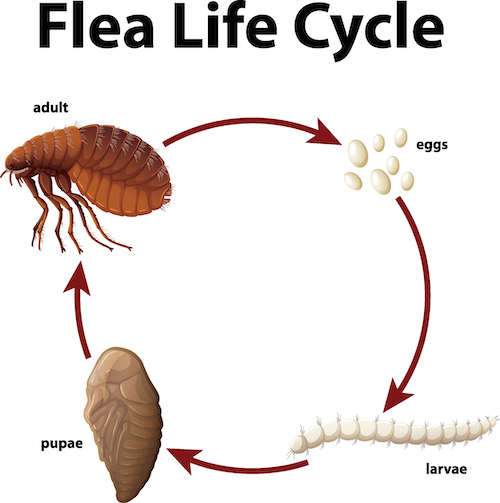Understanding the flea life cycle is the first step to getting rid of them. There are few things one has to take note of when you want to get rid of fleas and pets from the house. Top of the list is understanding the flea life cycle.
The flea life cycle consists of four different stages.
Egg
Larva
Pupa
Adult
A typical flea life cycle can take from a few weeks to several months to complete. This is depending on the humidity and environment. Fleas usually thrive in conditions with temperature ranging from 70-85 degree Fahrenheit with humidity of about 70 percent humidity. Let’s take a brief look at the four stages in the flea life cycle to get a clearer understanding.
Flea Eggs
This is the first stage in the flea life cycle and occurs when a female adult lays eggs. This happens in the aftermath of a blood meal from its host (which in most cases is usually a pet). Blood is an essential requirement for reproduction in adult fleas. Flea eggs are typically white, and they are very small. A female flea can lay as much as 40 eggs every day.
These eggs tend to fall off pets as they move. This allows them to spread throughout the environment where these pets are found. Statistics reveal that the flea eggs account for about 50 per cent of the whole flea population in your house.

An egg can develop from between two days to about two weeks depending on the conditions they find themselves. For cold and dry temperatures it can take a lot longer. If the temperature is warm and humid, flea eggs will hatch a lot faster.
Flea Larvae
Larvae usually cannot see and therefore will avoid coming in contact with light. They grow by consuming pre-digested blood commonly referred to as flea dirt. This is passed down from the adult fleas in the environment.
A flea larvae is about 0.25 inch in length and they are also white in some cases almost transparent in color. The flea larvae makes up about 35% of the total flea population. In the right environment, it will take about 5-20 days for the flea eggs to hatch, and move on to the next stage of the flea life cycle.
Flea Pupae
This stage makes up about 10% of the entire flea population. This is the final developmental stage in flea development before it matures to becoming an adult flea. The cocoon serves as protection for the adult flea before the adult itself comes out. If the conditions are not perfect for development of the adult, the cocoon shelters the adult for months and even years before the adult can develop.
This is usually because of the sticky outer coating that these cocoons have. It allows them to hide inside your carpet for long without being spotted and isn’t removed easily by sweeping or vacuuming. In addition, the cocoon protects the adults from chemicals. Adults do not emerge unless the presence of a host is made available. This is as a result of vibrations, body heat or increasing levels of carbon dioxide.
Mature Fleas
Adults begin to feed on their host few hours after emergence and start to breed few minutes after they have consumed their first meal and lay eggs some days after. Although female fleas cannot lay eggs unless they have fed on blood meals.
Adult fleas are flat-bodied in appearance, tiny and are usually dark colored. After feeding on the closest pet they come in contact with they start to look lighter and appear larger and begin to look more like a flea. These adult fleas make up below 5 percent of flea total population. They usually spend most of their days feeding off a host during which they eat, breed and start to lay eggs. They can survive on a host for several months.
Getting rid of fleas
You can make use of the knowledge you have now of fleas and how they breed to get rid of fleas in your environment. Clean your environment thoroughly by vacuuming and washing your bedding in steaming soapy water helps get rid of the eggs, larvae or pupae. It is always important that you seal of and remove the vacuum bags once you are done cleaning.
You can also hasten the development of the flea pupae with the use of a humidifier and also an increasing room temperature. As soon as all the hidden pupae have been developed ensure that they all gotten rid of properly.
You can use of cat flea and tick shampoo, sprays, dog flea and tick shampoo, dips, prescription flea and tick, spot-on medications or treatments from your local veterinarian. If you have any questions or concerns, especially in regards to your pet’s health or age, your veterinarian can help you make the best decision for treating your pet.
It is very difficult to get rid of fleas, however, ensure you are observant and make use of the right chemicals, ensure you do this in a very safe and secure way. Remember to concentrate on areas fleas stay a lot around the house.